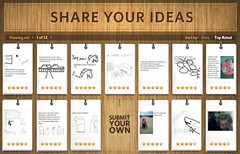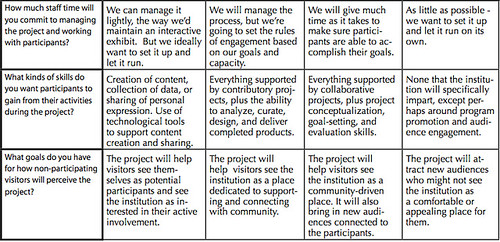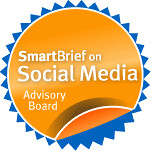
Source: Share Your Ideas
Note from Beth: I first encountered Nina Simon through her awesome blog back four or five years ago. I got a chance to meet her face-to-face for the first time at the Nonprofit Technology Conference in 2007. I'm a huge fan of work and the way she thinks - especially after she road the Scare House ride on the Santa Cruz boardwalk with me and did a brilliant reflection on its design.
Nina has written a fantastic book engagement called The Participatory Museum. I've purchase a two copies, one for me and one to give away. If you want a chance of winning a copy, leave a comment saying how you might apply some of the science of participation to your social media strategy.
Imagine sitting around a conference table planning an upcoming project that involves user-generated content. One colleague suggests that users should be able to contribute original work. Another thinks that users should not only contribute content but also have a hand in determining how it is used. A third argues that the project won’t be truly participatory unless users get to define what content is sought in the first place. How can you describe user participation in a shared language that helps your team make the right decision for your project?
Science has an answer. Last year, Rick Bonney and a team of educators and science researchers at the Center for Advancement of Informal Science Education (CAISE) tackled this question in a project designed to define the structures and benefits of public participation in science research (download the full report as a PDF here.) As far back as the 1880s, scientists have led “citizen science” projects in which amateurs are invited to participate in formal scientific research by volunteering to count birds, measure soil quality, or document non-native plant species.
Despite its long history, few researchers studied the use and impact of citizen science until the 1980s. Over the course of several projects at the Lab, Rick Bonney and others noted that different kinds of participation led to different outcomes for participants. When participants collected data, they learned a great deal about data collection processes but not so much about the overall scientific method. When, on the other hand, amateurs had the opportunity to help design scientific questions or disseminate research results, they often felt more ownership of the project and greater interest in using scientific methods to address their own community needs. Rick wanted a better way to describe what kinds of projects led to different community outcomes.
After a broad survey, Rick’s team defined three broad categories of public participation in scientific research: contribution, collaboration, and co-creation. These categories align roughly with the extent to which the public are involved in different stages of scientific research. In contributory projects, participants collect data in a scientist-controlled process. Scientists design the test questions, steer the data collection, and analyze the results. In collaborative projects, citizens collect data, but they also analyze results and draw conclusions in partnership with the scientists. In co-creative projects, the public develops the test questions, and scientists co-produce scientific regimens to address the community interest. While co-creative projects have the most lasting impact on participants, they tend to involve very small groups of participants and require a lot more work (and flexibility) on the part of the scientists who run them.
What does this have to do with nonprofits and social media? Like science labs, nonprofit organizations produce public-facing content under the guidance of authoritative experts. Like citizen science project leaders, many social media practitioners are seeking meaningful, sensible ways to invite users, customers, and citizens to participate in the development of high-quality work. I’ve been using these participatory categories to talk about how we’d like users to participate in different projects. Most of my work involves museums, but these categories can be useful in any project that involves user participation.
I’ve added one more category to the mix called hosted. Hosted projects are ones in which an organization turns over a portion of its facilities and/or resources to present programs developed and implemented entirely by users. This category is in some ways the most radical, because the organization is only minimally involved in the use of its content—but it is also potentially the most powerful for users, who can appropriate the content for whatever suits them.
What do these categories look like outside of the science environment? Here’s a brief definition and cultural example of each:
• In contributory projects, users are solicited to provide limited and specified objects, actions, or ideas to an institutionally controlled process. Blog commenters are contributors, as are people who engage in contests. The Victoria & Albert Museum’s World Beach Project is a wonderful contributory project in which people around the world make artworks on beaches per institutional specifications and submit images of their work to a central website. Participants feel like part of something bigger than themselves, but they don’t connect to each other personally as community members.
• In collaborative projects, users are invited to serve as active partners in the creation of institutional projects that are originated and ultimately controlled by the organization. Wiki users are often collaborators. They have some influence over the direction of the project but don’t steer it themselves. In the US Holocaust Memorial Museum’s Children of the Lodz Ghetto research project, participants work together with staff to do database research into the lives of thousands of Polish children during the Holocaust. Users report incredible connection to each other and to the project, but quality control is much more complex than in a simplified contributory project.
• In co-creative projects, community members work together with institutional staff members from the beginning to define the project’s goals and process based on community interests. Online, this may be a campaign that is started by a member and then supported and fueled with institutional help. In the physical world, at the Wing Luke Asian Museum in Seattle, staff members partner with visitors to co-produce exhibits based on community members’ interests and the institution’s collections. The resultant exhibitions are beautiful and well-received, and the institution accepts that the community process takes more time, effort, and humility than a standard exhibit design process.
• In hosted projects, users appropriate institutional content or resources for their own uses. Online, this may mean participants creating their own mashups or using organizational data to construct visualizations. When the Toronto Science Centre hosted the 888 YouTube Meetup, museum staff effectively invited YouTubers from all over the world to use the facility as a videographer’s playground. This generated many energetic videos set in the Science Centre, but many featured content that was not in-line with the institutional mission.
Contribution, collaboration, co-creation, hosted. No one model is better than the others. Nor should they even be seen as progressive steps towards a model of “maximal participation.” They each imply different levels of institutional control and participant involvement, but transformational experiences are possible in every type. Consider the difference between a book project in which an institution sources stories from users (contributory) and one in which the institution works with a small group of users to design the publication (collaborative). If the first project results in a book composed entirely of users’ voices and the second results in a volume that looks more like a “typical” institutional publication, which project is more participatory?
This question is impossible to answer, and for good reason. Participatory projects are most successful when you can find the right model for your staff culture, your users, and your goals. Here’s a chart that may help you figure out what type is best for your next project. While there are outlier innovative projects that defy categorization, this chart displays the fundamental characteristics of each model.


How will you invite participants to engage with your next project?

Nina Simon is an independent museum exhibit designer and publisher of the Museum 2.0 blog. She is the author of the new book The Participatory Museum, a practical guide to visitor participation in cultural institutions.





Beth - don't you mean she "rode" the ride?
http://dictionary.reference.com/browse/rode
Posted by: Smith | May 10, 2010 at 07:56 AM
Hi Beth and Nina,
Nice outline here. I did a similar one related to communities of practice as applied to a nonprofit environment. My question regarding this one is this: What if your organization falls into different categories for each of these questions? Do you go with the one that has the most chosen in a column/category, or do you choose different activities related to the columns in which the organization shows the most strengths? Of course, there is a lot of inherent overlap, as you mention here, which defies a clear cut answer, so some of this is building a willingness in the culture for experimentation and tolerated failure until you hit the right formula. Of course, that's going to vary from project to project as well as over time as new capabilities and needs come into the picture.
I'd love a book, of course, but I'm not sure that this comment qualifies, since I haven't explicitly shared examples.
Dianna Wiggins
Posted by: Dianna Wiggins | May 10, 2010 at 09:07 AM
Hi Beth and Nina
As Dianna said, great outline. And although each of the four models touch on it, and I'm sure you've considered it, but how would a fully crowdsourced model effect the project - including project management and implementation?
Just a thought...
BW
Lee
Posted by: Lee Smallwood | May 10, 2010 at 03:02 PM
Actually, I'm thinking about the act of consulting - and how this applies and shifts through the stages of a consulting relationship.
At Cause Effective, we work with community-based nonprofits to help them reimagine their funding base and often can see options they can't visualize at the start. They ask us to find money for them and we come back with uncovering all their hidden friends (which, of course, ultimately leads to $). My point is, there's a fine line in defining a consultancy inbetween co-creation or respectful collaboration - and having the infra-red consultant goggles which trump (if the group is indeed to move beyond their comfort zone).
I guess this didn't answer the social media part of the question - but in fact we are facing this very part of this question in re-purposing our social media strategy (including our blog www.CauseEffectivePerspective.net, which has great content but a silent community) - we are thinking all this through collectively right now.
Posted by: Judy Levine | May 10, 2010 at 04:19 PM
This is a wonderful framework to guide action. I work a lot with action research/learning/inquiry which has various modes of participation, and this frame is very helpful for that field.
I recently had a discussion with some global multi-stakeholder change networks that deal with "certification standards"...think FairTrade coffee, FSC-labelled forestry products (Forest Stewardship Council) and MSC-labelled seafood (Marine Stewardship Council). I pointed out that they are inconsistent in their use of "multi-stakeholder processes", and wondered why. For example, they all have multi-stakeholder global boards, but when it comes to actually certifying a specific producer the process is entirely technocratic: an auditor interviews stakeholders individually.
In the blog about Nina, you claim "transformational experiences are possible in every type"...but what do you mean by transformation, and are they really, and if transformation is the goal, surely these processes are not equivalent. This brings to light that there is another row needed, that asks "What is the goal for participants"...oddly, there's one for "non-participants" only.
When I say "transformation", I mean the shift in insight about how "one is" vis-a-vis others and a change in relationships that means change in power and what can be created together. For this to occur between organizations as well as individuals, the "contributory" model doesn't get you there...to take the certification examples in hand, they're applying the "contributory" model for stakeholders involved in a local product's certification, but to realize "transformation" in the stakeholder relationships locally they need an approach similar to the one they take globally...a co-creative process for planning and managing the resource. 2009 Nobel Laureate in Economics, Elinor Ostrom, writes a lot about this approach.
Posted by: Steve Waddell | May 11, 2010 at 05:58 AM
I love this chart!! Great jumping off point for considering key questions around community networks. Is there a free-standing or enlarge-able, or downloadable version anywhere? Thanks Beth!
Posted by: Margaret Conway | May 11, 2010 at 07:32 AM
Hi folks --
I'm coming a bit late to this discussion, but here are some thoughts (and a downloadable PDF version of the chart). You can download a pdf here, or you can see the chart in context by reading the full chapter it comes in here.
@Dianna, I've found that the chart works best on a project-by-project basis. The question of which model to use frankly comes down to staff personalities more than anything else. You can't "force" someone to accept a co-creative structure if he or she feels the need for more control over a project to make it successful. I've often worked with organizations that have pockets/departments working with community members in different configurations. Sometimes there are issues--particularly if community work in general is seen as inferior to "professional" work--and the most successful organizations are those in which staff can talk honestly and openly about their personal challenges to working more collaboratively.
@Steve, thanks for your articulate comment - in the context of your definition of transformation, what you say makes a lot of sense. In a museum/arts/learning context (the one in which I primarily work), transformation may be about self-concept as an artist or new connections to content or other people. For example, the Denver Community Museum, which featured exhibits produced entirely from public contribution, was a contributory project that had transformative power to help participants see themselves as makers and co-owners of a cultural experience. I do agree with you that another row is needed. Frankly, in the museum field, we have a real problem with participatory projects that are almost exclusively focused on the participants' own experiences and personal evolution. I believe that participatory projects will only become valued on a broad scale when they are seen as more than just personal experiences for a few participants but are also built into the work that the organizations do for the vast number of people/visitors/customers who are served every day.
Posted by: Nina Simon | May 11, 2010 at 09:31 AM
Beth and Nina, what a great and educational post. Learning about these kinds of differences and participation opportunities for stakeholders is always very valuable to me. Hope to read more posts like this in the future.
Posted by: Marcella Chamorro | May 11, 2010 at 12:08 PM
I would like to create a video project that is collaborative in order to attract more members and to influence the members we already have.
Posted by: Vanessa | May 12, 2010 at 02:15 PM